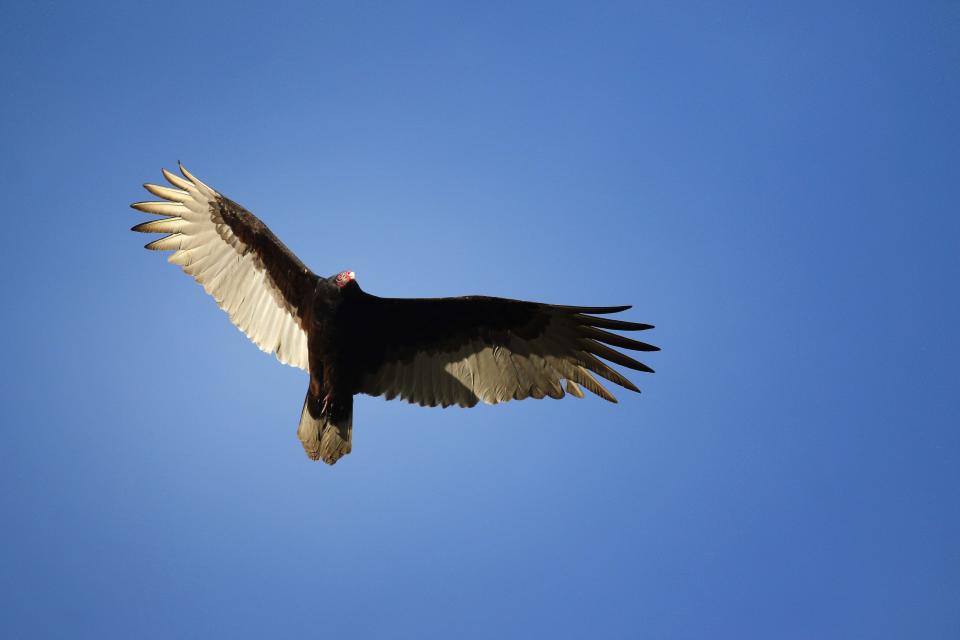Why are we seeing more vultures in the Evansville area?
Turkey vultures are not the loveliest birds. Most folks don't like them. And they are, shall we say, odiferous. But they're usually solitary or maybe in pairs, drifting slowly on the air currents, sniffing for dead stuff.
When the hunt succeeds, though, it's common to see a half dozen vultures squabbling over the rot.
Thus last week, seeing 38 soaring together gave me pause. And while I thought that was a startling sighting, the next day a friend only four miles away sent a photo of way more. Best I could count: 180.
My Facebook post about the incident drew reports of spectacular evening flights near vulture roosts in the Tri-State. Some totaled 100 or so birds most nights. Really? What happened that so many have gathered in this area when 50 years ago we rarely saw any?
That's not to mention that black vultures, close cousins to turkey vultures, have joined the roosts and flights. Until recently, they never dipped wings in area skies.
Beginning in the 1940s and through the 1990s, both vultures have expanded their ranges northward. The range expansion has paired with population expansion. Breeding areas, however, extend much farther north than wintering areas, and current range maps show only the southern tip of Indiana and parts south as turkey-vulture winter range.

Research is scant for what happens with wintering vultures. Even vultures that don't migrate seem to change behaviors in winter. According to Birds of the World (BOW), the online definitive avian resource, suggests wintering vultures may spend more time in areas without roads, may increase their use of urban areas, and year-round resident birds may shift their habitat use "in response to influx of migrants." Roosting preferences also "often shift from hardwood to conifers (presumably to maintain thermal cover)."
Strangely, though, northern breeders leapfrog over the northern edge of wintering territory and join residents farther south. For instance, northern Indiana breeders overwinter in southern Georgia and Florida.
So the 180 vultures photographed here last week weren't migrants. Or were they? Research doesn't verify where Canadian-breeding vultures overwinter. Maybe here?
Three other details leave me curious: First, while migrants tend to leave northern and central Indiana in mid-September, they typically return by late February − unless warm spells trigger early movement. We've had warm spells.
More:The birds we take for granted in the Tri-State are a rarity in other parts of the U.S.
Second, BOW notes that turkey vultures are "nomadic along the northern border of winter range." We're smack on that border.
Third, one landowner hosting a long-time vulture roost notes that the birds arrive in December and depart in early spring. The timing says migrants. Are these, then, those far northern US and Canadian breeders? Curiouser and curiouser.
Regardless of the source of the big kettles of vultures, we can appreciate their presence. After all, they're nature's garbage disposal. Without them, we'd be knee-deep in carrion.
Interestingly, turkey vultures are the only raptors that cannot kill their own prey. Given their keen sense of smell, the largest olfactory system of any bird, they can sniff out carrion within 12 to 24 hours of demise − from a mile away.
Rest assured, though, unless you've not bathed for awhile and are lying still in the sun, you needn't fear these huge birds with their six-foot wingspans. But if you harass them, they'll throw up on you; and their stomach acid dissolves bone.
For more information about birds and bird habitat, see Sharon Sorenson's books How Birds Behave, Birds in the Yard Month by Month, and Planting Native to Attract Birds to Your Yard. Follow daily bird activity on Facebook at SharonSorensonBirdLady, or email her at chshsoren@gmail.com.
This article originally appeared on Evansville Courier & Press: Why are we seeing more vultures in the Evansville area?

